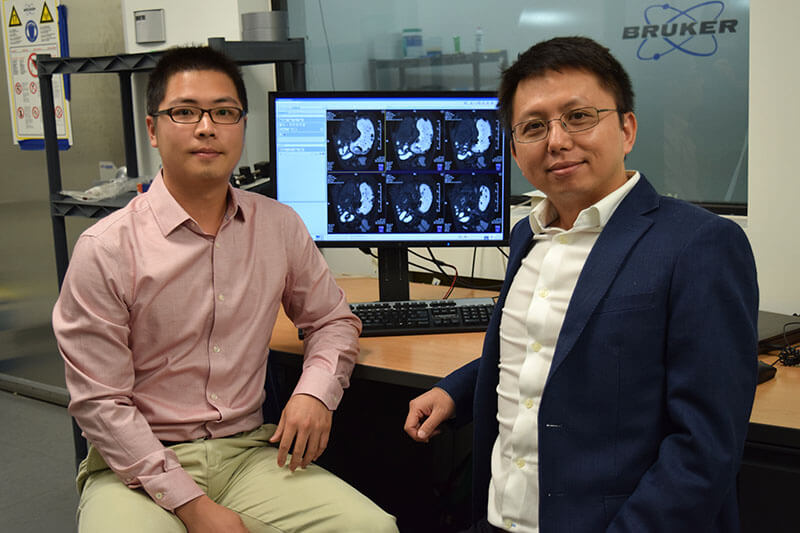Lo strumento MRI osserva come la stimolazione elettrica potrebbe curare i disturbi digestivi
Più di 60 un milione di persone negli Stati Uniti. soffre di disturbi del tratto gastrointestinale che potrebbero essere curati con la stimolazione elettrica, ma gli scienziati non comprendono appieno gli effetti della terapia su un organo critico: lo stomaco. I ricercatori della Purdue University hanno utilizzato una risonanza magnetica per mostrare come l’invio di stimolazione elettrica al nervo vago corregge con successo le complicazioni dello stomaco. La tecnica apre la strada a un trattamento più preciso che i farmaci e i cambiamenti nella dieta non hanno ottenuto.
 Una nuova tecnica di risonanza magnetica aiuta gli scienziati a capire come lo stomaco risponde alla stimolazione del nervo vago, che potrebbe offrire un trattamento più preciso per i disturbi digestivi. (Video della Purdue University/Kun-Han Lu) Scarica l'immagine
Una nuova tecnica di risonanza magnetica aiuta gli scienziati a capire come lo stomaco risponde alla stimolazione del nervo vago, che potrebbe offrire un trattamento più preciso per i disturbi digestivi. (Video della Purdue University/Kun-Han Lu) Scarica l'immagine“Infine, chiedendo a un paziente di sottoporsi a più scansioni MRI con diverse impostazioni di stimolazione elettrica, potremmo individuare la migliore impostazione di stimolazione per alleviare i sintomi di quel particolare paziente,” disse Kun-Han “Tom” Lu, un dottorato di ricerca. studente dentro ingegneria elettrica e informatica.
Il lavoro, che viene pubblicata come copertina della rivista Neurogastroenterologia e Motilità nel suo ottobre 2018 problema, è in linea con quello di Purdue salti giganti celebrazione, riconoscendo i progressi globali dell’università nel campo della salute, longevità e qualità della vita nell’ambito del 150° anniversario della Purdue. Questo è uno dei quattro temi della celebrazione annuale Festa delle Idee, progettato per mostrare Purdue come un centro intellettuale che risolve problemi del mondo reale.
I disturbi digestivi creano un onere medico di miliardi di dollari ogni anno.
Un indicatore importante di un disturbo digestivo è la velocità con cui lo stomaco si svuota del cibo, chiamato “svuotamento gastrico,” nell'intestino tenue per l'assorbimento dei nutrienti. Svuotamento gastrico lento nel disturbo della gastroparesi, per esempio, significa che i muscoli dello stomaco non si muovono correttamente.
La stimolazione del nervo vago consentirebbe ai medici di controllare la velocità con cui lo stomaco si svuota, curare efficacemente la gastroparesi.
“Alcuni protocolli di stimolazione per lo stomaco nell’uomo hanno già l’approvazione della FDA, ma si sono rivelati solo parzialmente efficaci,” disse Terry Powley, Illustre professore di Purdue Neuroscienza e il direttore della SPARC (Stimolare l'attività periferica per alleviare le condizioni) progetto, un’iniziativa del National Institutes of Health per mappare i circuiti neurali dello stomaco.
 I ricercatori della Purdue University Kun-Han Lu (sinistra) e Zhongming Liu (destra) stanno fornendo una valutazione in tempo reale della funzionalità dello stomaco per orientare terapie migliori. Scarica l'immagine
I ricercatori della Purdue University Kun-Han Lu (sinistra) e Zhongming Liu (destra) stanno fornendo una valutazione in tempo reale della funzionalità dello stomaco per orientare terapie migliori. Scarica l'immagine
Nell'ambito del progetto SPARC, I ricercatori della Purdue hanno proposto di utilizzare la risonanza magnetica in piccoli animali per avere una visione migliore degli effetti della stimolazione del nervo vago sullo stomaco.
“La risonanza magnetica non è invasiva, mostrare bene il contrasto dei tessuti e rendere più semplice la ripetizione di un esperimento per la verifica,” Lu ha detto. Un video di YouTube è disponibile all'indirizzo https://youtu.be/ewsx0g2suSE.
Lu ha stimolato il nervo vago per controllare lo sfintere pilorico nei ratti, la valvola che controlla il cibo che lascia lo stomaco e entra nell'intestino tenue. Ha poi creato ricostruzioni 3D delle immagini MRI nel tempo. Le immagini hanno mostrato che la stimolazione ha rilassato lo sfintere pilorico, accelerare lo svuotamento gastrico per correggere potenzialmente lo svuotamento ritardato in caso di gastroparesi, o altri tipi di malfunzionamento gastrointestinale.
“Questo metodo fornisce le informazioni fisiologiche per comprendere gli impatti di qualsiasi trattamento in modo che possa essere messo a punto per un organo specifico o un disturbo specifico,” disse Zhongming Liu, assistente professore di Ingegneria Biomedica e ingegneria elettrica e informatica.
I ricercatori intendono spingere la tecnologia per recuperare ancora più informazioni sulla fisiologia gastrica e condurre i propri test su diversi trattamenti sui disturbi gastrici.
fonte: www.purdue.edu, di Kayla Wiles


Lascia un commento
Devi accesso o Registrati per aggiungere un nuovo commento .